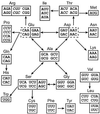Testing a biosynthetic theory of the genetic code: fact or artifact?
- PMID: 11087835
- PMCID: PMC17637
- DOI: 10.1073/pnas.250403097
Testing a biosynthetic theory of the genetic code: fact or artifact?
Abstract
It has long been conjectured that the canonical genetic code evolved from a simpler primordial form that encoded fewer amino acids [e.g., Crick, F. H. C. (1968) J. Mol. Biol. 38, 367-379]. The most influential form of this idea, "code coevolution" [Wong, J. T.-F. (1975) Proc. Natl. Acad. Sci. USA 72, 1909-1912], proposes that the genetic code coevolved with the invention of biosynthetic pathways for new amino acids. It further proposes that a comparison of modern codon assignments with the conserved metabolic pathways of amino acid biosynthesis can inform us about this history of code expansion. Here we re-examine the biochemical basis of this theory to test the validity of its statistical support. We show that the theory's definition of "precursor-product" amino acid pairs is unjustified biochemically because it requires the energetically unfavorable reversal of steps in extant metabolic pathways to achieve desired relationships. In addition, the theory neglects important biochemical constraints when calculating the probability that chance could assign precursor-product amino acids to contiguous codons. A conservative correction for these errors reveals a surprisingly high 23% probability that apparent patterns within the code are caused purely by chance. Finally, even this figure rests on post hoc assumptions about primordial codon assignments, without which the probability rises to 62% that chance alone could explain the precursor-product pairings found within the code. Thus we conclude that coevolution theory cannot adequately explain the structure of the genetic code.
Figures



Similar articles
-
An extension of the coevolution theory of the origin of the genetic code.Biol Direct. 2008 Sep 5;3:37. doi: 10.1186/1745-6150-3-37. Biol Direct. 2008. PMID: 18775066 Free PMC article.
-
The lack of foundation in the mechanism on which are based the physico-chemical theories for the origin of the genetic code is counterposed to the credible and natural mechanism suggested by the coevolution theory.J Theor Biol. 2016 Jun 21;399:134-40. doi: 10.1016/j.jtbi.2016.04.005. Epub 2016 Apr 8. J Theor Biol. 2016. PMID: 27067244
-
The genetic code is very close to a global optimum in a model of its origin taking into account both the partition energy of amino acids and their biosynthetic relationships.Biosystems. 2022 Apr;214:104613. doi: 10.1016/j.biosystems.2022.104613. Epub 2022 Jan 24. Biosystems. 2022. PMID: 35085754
-
Origin and evolution of the genetic code: the universal enigma.IUBMB Life. 2009 Feb;61(2):99-111. doi: 10.1002/iub.146. IUBMB Life. 2009. PMID: 19117371 Free PMC article. Review.
-
Coevolution theory of the genetic code at age thirty.Bioessays. 2005 Apr;27(4):416-25. doi: 10.1002/bies.20208. Bioessays. 2005. PMID: 15770677 Review.
Cited by
-
An integrated, structure- and energy-based view of the genetic code.Nucleic Acids Res. 2016 Sep 30;44(17):8020-40. doi: 10.1093/nar/gkw608. Epub 2016 Jul 22. Nucleic Acids Res. 2016. PMID: 27448410 Free PMC article. Review.
-
Optimality of the genetic code with respect to protein stability and amino-acid frequencies.Genome Biol. 2001;2(11):RESEARCH0049. doi: 10.1186/gb-2001-2-11-research0049. Epub 2001 Oct 24. Genome Biol. 2001. PMID: 11737948 Free PMC article.
-
Optimal Evolution of the Standard Genetic Code.J Mol Evol. 2021 Feb;89(1-2):45-49. doi: 10.1007/s00239-020-09984-8. Epub 2021 Jan 24. J Mol Evol. 2021. PMID: 33486548 Free PMC article.
-
Computer-modeling origin of a simple genetic apparatus.Proc Natl Acad Sci U S A. 2001 Jul 17;98(15):8620-5. doi: 10.1073/pnas.141379398. Proc Natl Acad Sci U S A. 2001. PMID: 11459992 Free PMC article.
-
A content-centric organization of the genetic code.Genomics Proteomics Bioinformatics. 2007 Feb;5(1):1-6. doi: 10.1016/S1672-0229(07)60008-4. Genomics Proteomics Bioinformatics. 2007. PMID: 17572358 Free PMC article.
References
-
- Crick F H C. J Mol Biol. 1968;38:367–379. - PubMed
-
- Dillon L S. Bot Rev. 1973;39:301–345.
-
- Knight R D, Freeland S J, Landweber L F. Trends Biochem Sci. 1999;24:241–247. - PubMed
-
- Sonneborn T M. In: Evolving Genes and Proteins. Bryson V, Vogel H J, editors. New York: Academic; 1965. pp. 97–166. - PubMed
Publication types
MeSH terms
Substances
LinkOut - more resources
Full Text Sources

